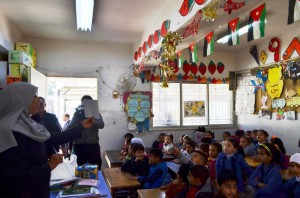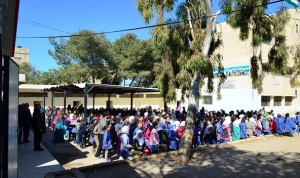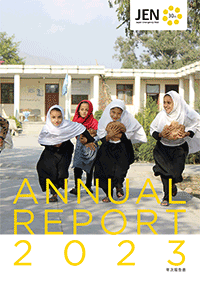The educational crisis caused by the crisis in Syria
Jordan, in the Middle East, is a small country (92,300 km2)) in area, which is almost as large as Hokkaido (83,424km2) in Japan. Jordan is a non-oil-producing country influenced by changing fuel or food prices abroad. Being poor in water resources and having no conspicuous means to acquire foreign money, the structure of the state is fragile both socially and economically.
Surrounded by Israel in the west, Iraq in the East, Saudi Arabia in the south and Syria in the north, the state is apt to be influenced by the security situations in its neighboring countries. Jordan has admitted refugees from Palestina and Iraq. The inflow of Palestinian refugees began after the Six-Day War and now it is said that two thirds of the whole population of about 7.5million are residents of Palestinian descendants.
In addition, the crisis in Syria which occurred in 2011 forced a great number of Syrian refugees to rush into the state. It is said that Jordan has admitted about 1.4 million people out of 4.3 million refugees and 630 thousand people have been registered and acknowledged by the Office of the United Nations High Commissioner for Refugees (UNHCR). These refugees account for about 19% of the whole population in Jordan.
The Jordanian government suffers for the recovery of business and cutbacks of financial deficit, but on the other hand, spends a quarter of its state budget on refugee support. Consequently, the state has been driven into a severe financial condition by admitting the rapidly increasing Syrian refugees.
It is not well known that over 80% of Syrian refugees are living in the general society called ‘host community ’which is outside of the refugee camps. Many of them are living in urban areas.
The government of Jordan offers an educational opportunity to the children of those Syrian refugees who are registered and acknowledged as refugees. The number of Syrian refugee pupils who entered public school in Jordan in 2015 is 143,500, which is an increase by 60% from the previous year. The government is planning to admit 50,000 more Syrian refugee pupils in 2016. It is said that half of the 1.4 million Syrian refugees in Jordan are children and it is thought that there will be the extended number of Syrian refugee children in public schools in the country.
The opportunity of education in Jordan is important for the Syrian people to manage the reconstruction of their home country when the crisis in Syria comes to an end and they return home. However, due to the increase of Syrian refugee pupils, public schools in Jordan admitting refugees will suffer from insufficiency of infrastructure and teachers, and the decline in quality of education and/or violence in schools will be a serious problem. In order to admit Syrian refugee pupils, almost 100 public schools (about 3 % of all schools) have introduced two-shift system. It is difficult for the Jordanian government, which is already in a severe financial condition, to invest money to improve the infrastructure of schools or to reduce the burden on teachers, and therefore public schools have no choice but to shoulder a heavy burden. In nearly all schools which introduced the two-shift system, Jordanian pupils are taught in the morning and Syrian pupils in the afternoon.
【In the classroom of first grade of elementary school, 3 or 4 children share a desk for two children】

【The pupils of the school take up all the space on the floor】

Donating countries, cooperating with the Jordan government, worked out a supporting policy to abolish the two-shift system and enable Syrian pupils to go to morning school by the year of 2019. The aim is to ensure Syrian pupils educational opportunities to prevent a “Lost Generation” caused by the Syrian crisis, while reducing the burden on public schools in Jordan.
In order to avoid the educational crisis of Syrian refugees living in the host community, it is also necessary to support people in the country admitting refugees.
【JEN is now accepting donations. Your help would be very much appreciated.
DONATE here】

![Jordan[Syrian refugees] Blog](/en/project/images/mainimg_project_jordan.jpg)




